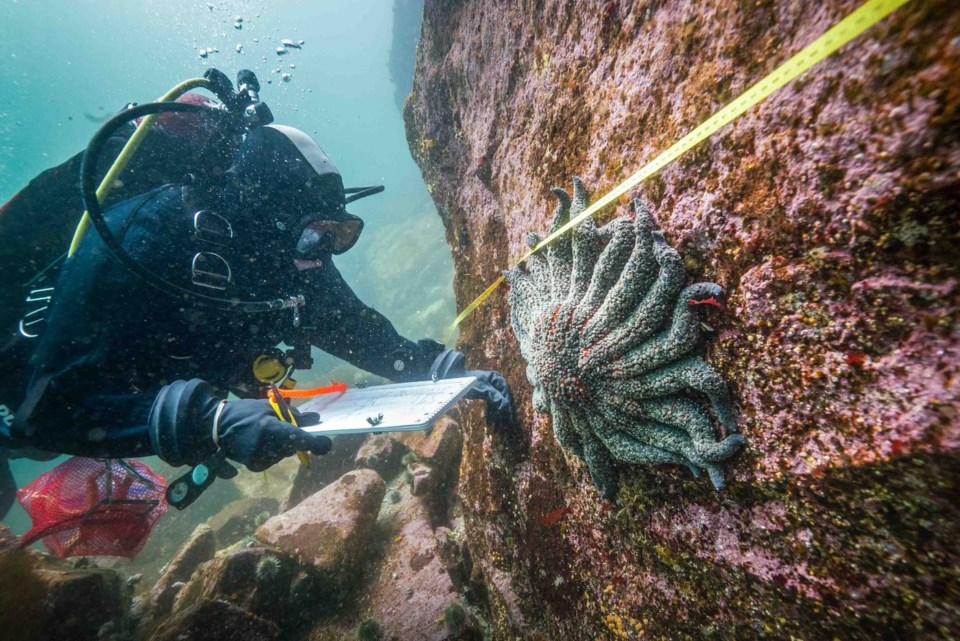Alyssa Gehman vividly recalls seeing starfish for the first time while on a kayaking trip in British Columbia's Desolation Sound in Grade 8.
"I just remembered (seeing) a lot of the colours and the excitement of the colours in the water," said Gehman, who is now a scientist with the Hakai Institute, a group that conducts long-term scientific research on remote locations on B.C.'s coast.
But the ocean isn't as colourful now after a wasting disease tore through all varieties of sea stars along the North American West Coast in 2013, wiping out most of the population.
It was especially hard on sunflower sea stars, she said, killing 90 per cent of their population in just a few years.
But a tip from some divers looking for rockfish on B.C.'s central coast set off research that could help the recovery of the Pacific coast's sea star population.
Gehman said divers with the Central Coast Indigenous Resource Alliance returned from the Burke Channel off the central coast with stories of seeing many sunflower sea stars, the multi-legged animal that can grow as big as a large pizza.
That's when she went for her own dive, she said.
"My first time diving in Burke, it really was almost overwhelming how much it looked like it used to look when we went diving before sea star wasting disease," said Gehman.
"That means that we're really looking at the healthy population," said Gehman.
A new study published this month in Proceedings of the Royal Society B: Biological Sciences says the cold-water fiords on the central coast may hold a key to sea star survival by serving as a marine refuge for critically endangered sunflower sea stars.
Gehman is a co-author of the study, conducted with the help of Fisheries and Oceans Canada and the Central Coast Indigenous Resource Alliance, who first reported seeing the sunflower starfish in the deepwater trenches in 2019.
Starfish are a keystone species and had kept populations of sea urchins in check, which in turn allowed kelp forests to grow.
The sunflower stars are voracious predators, eating most things living on the bottom of the ocean, including sea urchins, said Gehman, who's also an adjunct professor in the UBC Institute of Oceans and Fisheries.
Gehman said the loss of starfish has been "really personal" to her and watching the wasting disease go through the population is "gruesome."
"It's tragic to watch them die, their arms will walk away from their bodies, so they lose their arms and they get sort of these twisting behaviours that really look sick," said Gehman.
"They can go from looking fine to kind of a pile of goo with arms distributed in a matter of days," she added.
There has been a lot of evidence suggesting that hotter-than-expected temperatures in the ocean waters combined with the diseases to create a "perfect storm" for the sunflower stars, said Gehman.
The study says lower temperature and high salinity in the fiord's water appeared to be a key for survival.
"These patterns suggest that fiords provide refuge from consequences of (sea star wasting disease) and protecting these populations could be imperative for the species," it says.
Gehman said one of their main questions was whether the fiords are a place where the wasting diseases couldn't reach.
"We actually do see the disease in the fiords, but what we don't see is massive die-offs as a result of the disease, and so that lower temperature appears to be reducing the cost in some way," said Gehman.
The study says there are several of these deep trenches off B.C.'s central coast, with the longest one measuring almost 180 kilometres.
Gehman said the fiords are "quite complex," with arctic outflow during the winter that could create cold, high oxygen water, which turns out to be a "great condition" for these sea stars to live.
In summer, the fiords have glacial run-off, with the fresh water staying near the surface, working as a lid by keeping the cold water a couple of meters deep and stopping the sea stars from coming up to the surface.
"So, sunflower stars, I think without that lid, they would be happy to go up to the surface, but they don't like fresh water," she said.
"So, it essentially traps them a little bit in this cold condition, and by being in the cold condition, that actually helps their disease response."
The study said the population of the sunflowers in the fiords was 'highest in cool water temperatures."
Gehman said it's necessary to keep temperatures in mind when we are thinking about how to recover sea star populations.
"Potentially, areas that are cooler are going to be more successful, and this is definitely going to guide future research. We need to understand more about this relationship between temperature and disease, so that's something that I hope to be able to do next," said Gehman.
This report by The Canadian Press was first published April. 2, 2025.
Nono Shen, The Canadian Press



